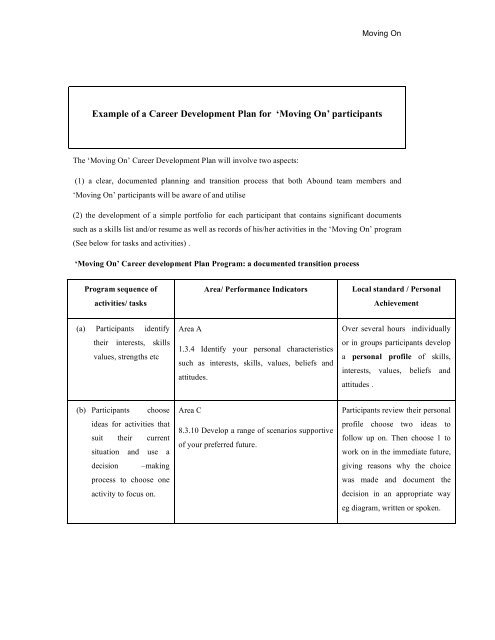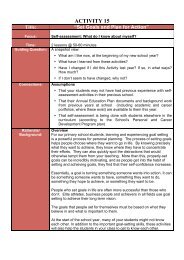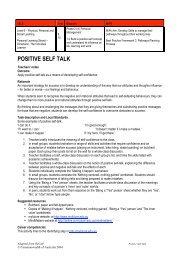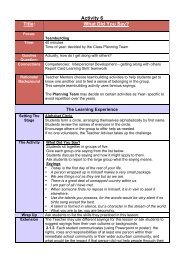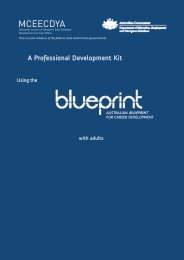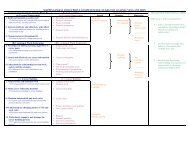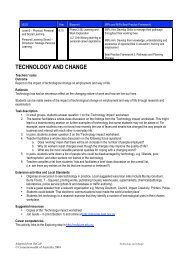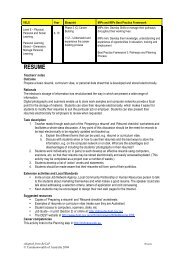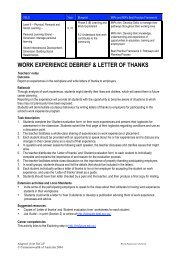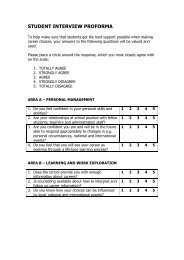Example of a Career Development Plan for - Blueprint - Australian ...
Example of a Career Development Plan for - Blueprint - Australian ...
Example of a Career Development Plan for - Blueprint - Australian ...
You also want an ePaper? Increase the reach of your titles
YUMPU automatically turns print PDFs into web optimized ePapers that Google loves.
Moving On(c) Participants list theirrequirements that willneed to be consideredin order to take part inpart in the learning,volunteering or workactivity/ exploration.Area C8.3.12 <strong>Plan</strong> and complete steps required tomake an effective transition (from school topost-secondary education/training programs orwork, or to re-enter the work<strong>for</strong>ce).Participants ( with support orindependently) explore thechoice <strong>of</strong> activity and make a list<strong>of</strong> factors that will impact on thedecision ( ie transport, cost, level<strong>of</strong> support, physical needs etc inthe activity according to theindividual and the activity. )(d) Participants work outtheir strategies and aplan that will enableparticipation in theactivity, (includingskills that will need to bedeveloped, prior totaking part in theactivity. )Area C8.3.12 <strong>Plan</strong> and complete steps required tomake an effective transition (from school topost-secondary education/training programs orwork, or to re-enter the work<strong>for</strong>ce).Participants ( with support orindependently) develop apersonal action plan, includingpersonal strategies and a timeline<strong>for</strong> participation in the activityeg transport, costs, level <strong>of</strong>support, physical needs etc(e) Participants take part innominated activity.Area C11.3.10 Develop and pursue short term actionplans in light <strong>of</strong> your desired career goals andaspirations.Participants attend/take part inthe activity the activity <strong>for</strong> therequired time, keep simple notesabout the activity and completethe activity. Or give validreasons <strong>for</strong> non completion andwork out what were the factorsthat would lead to satisfactorycompletion or a more appropriatealternative.
Moving On(f)Participants take part inself assessment activities(and demonstrateopenness to theassessment <strong>of</strong> others) reparticipation in theactivity.Area B4.4.10 Assess your skills, knowledge andattitudes towards learning and determine howthese enhance your career opportunities.Area A1.4.7 Examine your personal achievements andacknowledge their influences on your selfconcept.Participants self assess theirparticipation in the activityduring the activity and at the end<strong>of</strong> the activity using a designatedself assessment tool. They alsoevaluate the comments andsuggestions <strong>of</strong> others in order toassess skills, knowledge andattitudes acquired during theactivity. .(g) Participants determinefuture activity (usingtheir own ideas andthose <strong>of</strong> significantothers.)Area C11.4.11 Re-examine your career goals, actionplans and your strategies <strong>for</strong> dealing withtransition periods and determine whether or notit is necessary to adjust them.Participants review theirexperience <strong>of</strong> the activity andchoose future activities based on(i) their future needs (ii) inputfrom significant others. Choiceis then made and steps (a) –(f)repeated.(2) Simple portfolio <strong>for</strong> each participantFor participants with an acquired brain injury (ABI) having a documented record <strong>of</strong> currentskills, interests and plans etc is a great benefit since memory loss can be an ongoing difficulty.The portfolio will there<strong>for</strong>e contain examples <strong>of</strong> life achievements and pr<strong>of</strong>ile and plans (a, b, c,d) as well as a record <strong>of</strong> the transition processes (e) . Each person’s portfolio will be quitedifferent but evidence <strong>of</strong> significant steps made and validation <strong>of</strong> their life, learning and workjourney.(a) Personal pr<strong>of</strong>ile skills, interests, values, beliefs and attitudes(b) Resume(c) Life Achievements(d) <strong>Plan</strong>s <strong>for</strong> the future (leisure, volunteering, learning, work )
Moving On(e) Activities in ‘Moving On’ program (During involvement with ‘Moving On’ there maybe several activities undertaken and each time a new activity is recorded to reflect the stepsin the transition process i.e.:• Reasons <strong>for</strong> choosing activity• List <strong>of</strong> factors to consider eg transport , cost• Action plans• Diary /notes re the activity• Self assessment activities• Review <strong>of</strong> activity• <strong>Plan</strong> new activityEVALUATION(1) Evaluation <strong>of</strong> ‘Moving On’ <strong>Career</strong> development <strong>Plan</strong> Program: documented PROCESSQuestions to be answered by the Abound team1. Referral into the ‘Moving On’ program• Was the referral process into the Moving On program successful?• Were the referral pr<strong>of</strong>ormas easy to use?• What changes need to be made to the referral pr<strong>of</strong>ormas and the processes?2. Participant activities• Did the series <strong>of</strong> tasks work well as a sequence?• Were the per<strong>for</strong>mance indicators appropriate <strong>for</strong> the task? Are there moreappropriate indicators?• How appropriate were the local standards /personal goals?• What were the participant reactions to the process and tasks?• What changes need to be made to the task/ indicators/local standards/personalgoals? (Take into consideration staff and participant reactions and suggestions)
Moving On(2) Evaluation <strong>of</strong> simple Portfolio <strong>for</strong> each participant: PRODUCT• Were the portfolios added to /constructed during the program?• Did the participants do most <strong>of</strong> the construction?• How much assistance was needed?• What measures can be taken to enhance more independent construction <strong>of</strong> portfolios?• What were the participants’ reactions to portfolios?(3) Use <strong>of</strong> evaluation results• Who will need to see the evaluation results?• How will they be distributed?• What <strong>for</strong>mat should they take?• Who in EACH will need to make program decisions based on these evaluation results?• What documentation will need to be changed to reflect these changes?• How will the changes impact on staff, participants and partners?
Moving OnAttachment 3 : Trialling an alternative version <strong>of</strong> Appendix AHow well do you do the following things ? Not Verywell…………………………………… …….. well1. Build and maintain positive self concept …………………………………………2. Interact positively and effectively with others ……………………………………………………….3. Change and grow throughout life …………………………………………………….4. Participate in life-long learning supportive <strong>of</strong> career goals …………………………..5. Locate and effectively use career in<strong>for</strong>mation ………………………………………..6. Understand the relationship between work, society and the economy ……………….7. Secure/create and maintain work ……………………………………………………..8. Make career enhancing decisions …………………………………………………….9. Maintain balanced life and work roles………………………………………………10. Understand the changing nature <strong>of</strong> life and work roles……………………………….11. Understand, engage in and manage the career building process ………
Attachment 4 : Trialling Local standardsABCD trial projectTask 3: selecting career competencies and per<strong>for</strong>mance indicators and establishing local standards.Moving On<strong>Career</strong> competencies<strong>Career</strong> competencies are the broad goals <strong>for</strong> career developmentArea A – Personal managementCompetency 1, 2 and 3Area B – learning and wok explorationCompetency 4, 5 and 6Area C - <strong>Career</strong> buildingCompetency 7, 8, 9, 10 and 11Per<strong>for</strong>mance indicatorsPer<strong>for</strong>mance indicators are the general objectives describing specific knowledge, skills and attitudes that individuals need to develop to achieve acareer competency. Full details are covered in chapter 3. <strong>for</strong> our purposes we will use the ones below.<strong>Career</strong>competencyAreaCompetency Phase 1 Phase 2 Phase 3 Phase 4Area A -personalmanagement1. BUILD ANDMAINTAIN POSITIVESELF CONCEPT1.1 build a positiveself concept whilediscovering itsinfluence on yourselfand others1.2 Build a positiveself concept andunderstand itsinfluence on life andwork1.3 Develop abilitiesto maintain apositive self concept1.4 Improve abilitiesto maintain apositive self concept
Moving OnLocal standardsThe local standards describe what individuals will do to achieve a specific per<strong>for</strong>mance indicator, how well they need to do it, and the conditionsunder which they will per<strong>for</strong>m the task.(Attachment 4 continued)Activity to establish local standards.For each person in your trail, mark the relevant per<strong>for</strong>mance indicator that each person has acquired and then write specifically what they did toachieve it as the local standard.Stage Phase 1 Phase 2 Phase 3 Phase 4 Local Standard1. BUILD ANDMAINTAINPOSITIVE SELFCONCEPT1.1 Build a positive selfconcept while discovering itsinfluence on yourself andothers1. Acquire 1.1.1 Explore the nature <strong>of</strong>personal characteristics such asinterests, likes and dislikes,personal qualities, strengths andweaknesses1.1.2 Discover how positivecharacteristics are the basis <strong>of</strong> apositive self concept1.1.3 Understand how your selfconcept influences yourbehaviours1.1.4 Understand how yourbehaviours influence thefeelings and behaviours <strong>of</strong>others1.2 Build a positive selfconcept and understand itsinfluence on life, learningand work1.2.1 Discover how behavioursand attitudes affect school, workand family situations1.2.2 Understand how theenvironment influences attitudesand behaviours1.2.3 Understand the nature <strong>of</strong>values and beliefs, and exploretheir influence on self concept.1.2.4 Discover the personal andpr<strong>of</strong>essional benefits <strong>of</strong>developing a positive selfconcept and the consequences <strong>of</strong>developing a negative one1.3 Develop abilities tomaintain a positive selfconcept1.3.1 Understand howindividual characteristics suchas interests, skills, values,beliefs and attitudes contributeto achieving personal, social,educational and pr<strong>of</strong>essionalgoals1.3.2. Understand theimportance <strong>of</strong> giving andreceiving feedback tomaintaining a positive selfconcept1.3.3 Understand theimportance <strong>of</strong> allies (e.gfriends and supporters) tomaintaining a positive selfconcept1.4 improve on abilities tomaintain a positive selfconcept1.4.1 Understand the influence<strong>of</strong> personal characteristics(skills, knowledge, attitudes,interests, values, belief andbehaviours) on careerdecisions1.4.2 Understand howachievements related to work,learning and leisure influenceyour self conceptHow has this beenachieved? Write what theperson has done todemonstrate theper<strong>for</strong>mance indicator.2. Apply 1.1.5 Identify your positivepersonal characteristics (skills,interests, personal qualities andstrengths) as seen by you andothers1.1.6 Demonstrate behavioursand attitudes that reflect apositive self concept1.2.5 Describe your self concept1.2.6 Practise behaviours inschool, work and familysituations that reflect a positiveattitude about yourself1.3.4 Identify your personalcharacteristics such as yourinterests, skills, values, beliefsand attitudes1.3.5 Identify behaviours andattitudes that reflect your selfconcept1.3.6 Identify your allies andexternal assets1.3.7 Demonstrate giving and1.4.3 Explore how your owncareer decisions have been andstill are influenced by personalcharacteristics (skills,knowledge, attitudes, interests,values, belief and behaviours).1.4.4 Identify your personalachievements related to work,learning and leisure1.4.5 Adopt behaviours andattitudes that project a positive
eceiving feedback in waysthat build a positive selfconceptself concept.Moving On3. Personalise 1.1.7 Evaluate which <strong>of</strong> yourbehaviours and attitudescontribute either positively ornegatively to your self concept4. Act 1.1.8 Adapt your behaviours andattitudes in order to improveyour self concept1.2.7 Evaluate the impact <strong>of</strong>your self concept on you andothers at home, school or work1.2.8 Change behaviours andattitudes in order to improveyour self concept so that itcontributes positively to yourlife, learning and work activities1.3.8 Assess how yourpersonal characteristics andbehaviours are reflected inyour life, learning and workgoals1.3.9 Assess the part that yourallies play in achieving yourlife, learning and work goals1.3.10 Adopt behaviours andattitudes that will help youreach your life, learning andwork goals1.4.6 Re-examine yourpersonal characteristics anddetermine those that contributepositively to the achievement<strong>of</strong> your life, learning and workgoals1.4.7 Examine your personalachievements andacknowledge their influence onyour self concept1.4.8 Improve your life,learning and work activities bymaximising your positivecharacteristics1.4.9 Engage in life, learningand work activities thatvalidate all aspects <strong>of</strong> your selfand provide a sense <strong>of</strong> personalachievement
Moving OnAttachment 5This was used at the ACFE conference in October 2006 at a <strong>Blueprint</strong> workshop<strong>for</strong> ACFE providers in the Eastern region.The ‘<strong>Blueprint</strong>’Pre presentation1. What is the full name <strong>of</strong> the ‘<strong>Blueprint</strong>’?2. What is it about?3. Why could this be important <strong>for</strong> your students and local community?4. What are the main competencies it deals with?5. In what ways could the ‘<strong>Blueprint</strong>’ be used in your provider?
Moving On6. Can you suggest <strong>of</strong> ways the <strong>Blueprint</strong> could be used between providers or agencies?7. What problems do you think there are <strong>for</strong> implementing the use <strong>of</strong> the <strong>Blueprint</strong> in your provider?8. Could you please give an indication <strong>of</strong> your ‘excitement’ level about the ‘<strong>Blueprint</strong>’ on the continuumbelow. And could you please make a few comments about your ‘level’ eg why you feel as you do.…..……………………………………………………………….NotVeryexcitedexcited…………………………………………………………………………………………………………………………………………………………………………………………………………………………………………………………………………………………………………………………………………9. Do you have any other comments?…………………………………………………………………………………………………………………………………………………………………………………………………………………………………………………………………………………………………………………………………………Thank you <strong>for</strong> your participation


